For Your Spa Holidays: 7 Best Hot Springs In The World
A hot spring, hydrothermal spring, or geothermal spring is a spring produced by the emergence of geothermally heated groundwater onto the surface of the Earth. The groundwater is heated either by shallow bodies of magma (molten rock) or by circulation through faults to hot rock deep in the Earth's crust. In either case, the ultimate source of the heat is radioactive decay of naturally occurring radioactive elements in the Earth's mantle, the layer beneath the crust.
Hot springs also offer the best therapeutic and medicinal benefits and have been used as a source of relaxation for many years. If you are looking for a spa experience, take a look at these 7 best hot springs around the world.
1. Blue Lagoon, Iceland
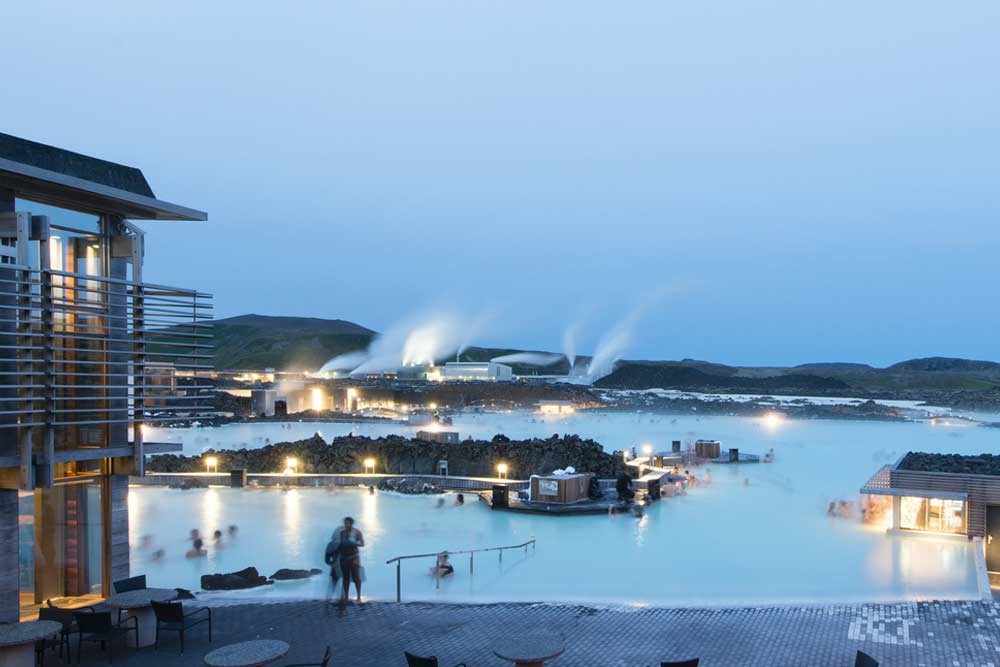 |
| Photo: Escales - Ponant |
The Blue Lagoon is an outdoor spa located just outside of Grindavík, Iceland. From massages to cocktails, this lovely spa will provide you with the relaxation and rejuvenation that you deserve. The Blue Lagoon offers a variety of day visits, overnight accommodation, and dining options.
This hot spring was created with a little help from humans, but it is filled with many types of healing elements that occur naturally. From the mineral-rich brackish water to the exfoliating mud, this spa offers rejuvenating treatments in forms that you’d never imagine, according to Hekla.
The lagoon is man-made. The water is a byproduct from the nearby geothermal power plant Svartsengi where superheated water is vented from the ground near a lava flow and used to run turbines that generate electricity. After going through the turbines, the steam and hot water pass through a heat exchanger to provide heat for a municipal water heating system. Then the water is fed into the lagoon.
The rich mineral content is provided by the underground geological layers and pushed up to the surface by the hot water used by the plant. Because of its mineral concentration, water cannot be recycled and must be disposed of in the nearby landscape, a permeable lava field that varies in thickness from 50 cm (20 in) to 1 m (3.3 ft). After the minerals have formed a deposit, the water reinfiltrates the ground, but the deposits render the ground impermeable over time, so the plant needs to continuously dig new ponds in the nearby lava field.
2. Pamukkale, Denizli, Turkey
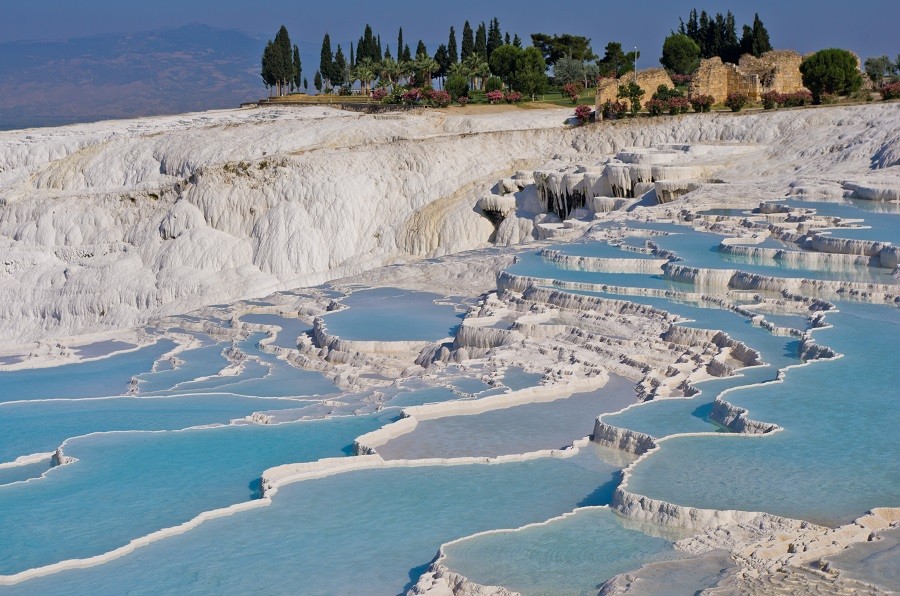 |
| Photo: MOMENTS Journal |
In Turkish Pamukkale means ‘Cotton Castle’. The city is located in the inner Aegean region, in the River Menderes Valley. Tectonic movements on the basin of the Menderes River triggered the rise of multiple hot springs. The water from these springs contains a large mineral content, with chalk, limestone, and travertine cascading down the mountain, giving rise to the complexion of the mountains; resembling a frozen waterfall. The waters contain a large amount of hydrogen carbonate and calcium, which results in the precipitation of calcium bi-carbonate. For details on tours, visit our Pamukkale tour page that includes 1 and 2-day bus tours from Cappadocia to Ephesus. You can also visit our broader Cappadocia region tours for some great holiday options.
The combination of all the above attribute, make the landscape surreal and Pamukkale is on the World Heritage list. Long before this listing, the Romans recognized this appeal and built a spa city, Hierapolis, according to Alaturka Turkey.
3. Terme Di Saturnia, Italy
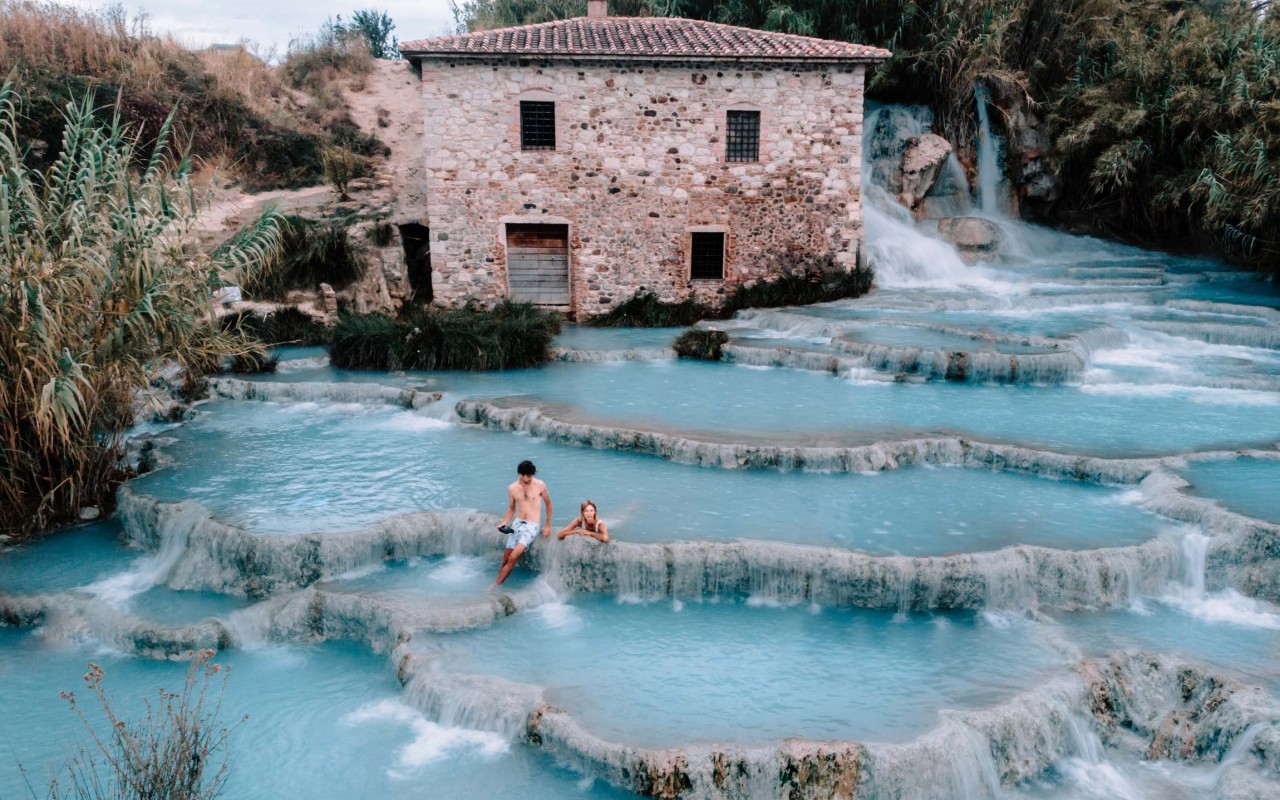 |
| Photo: Voyage in Style |
The Terme di Saturnia are a group of springs located in the municipality of Manciano in Italy, a few kilometers from the village of Saturnia. The springs that feed the baths, which are found in the south-eastern valley, cover a vast territory that stretches from Mount Amiata and the hills of Fiora and Albegna rivers to the Maremma grossetana at Roselle (Terme di Roselle) and Talamone (Terme dell'Osa).
The sulfurous spring water is at a temperature of around 37.5 °C (99.5 °F). The main thermal waterfalls are the Mill Falls, located at an old mill as well as the Waterfalls of Gorello.
The yield of the source is about 800 liters per second, which guarantees an optimal replacement of water. The chemical make-up is sulfur, carbon, sulfate, bicarbonate-alkaline, earth, with the presence of hydrogen sulfide gas and carbon dioxide. The minerals dissolved in water amount to 2.79 grams per liter.
The area of Saturnia Spa contains a luxury spa of Terme di Saturnia, where, in addition to various thermal treatments, thermal perfumes and creams are sold.
4. Chena Hot Springs, Fairbanks North Star Borough, Alaska
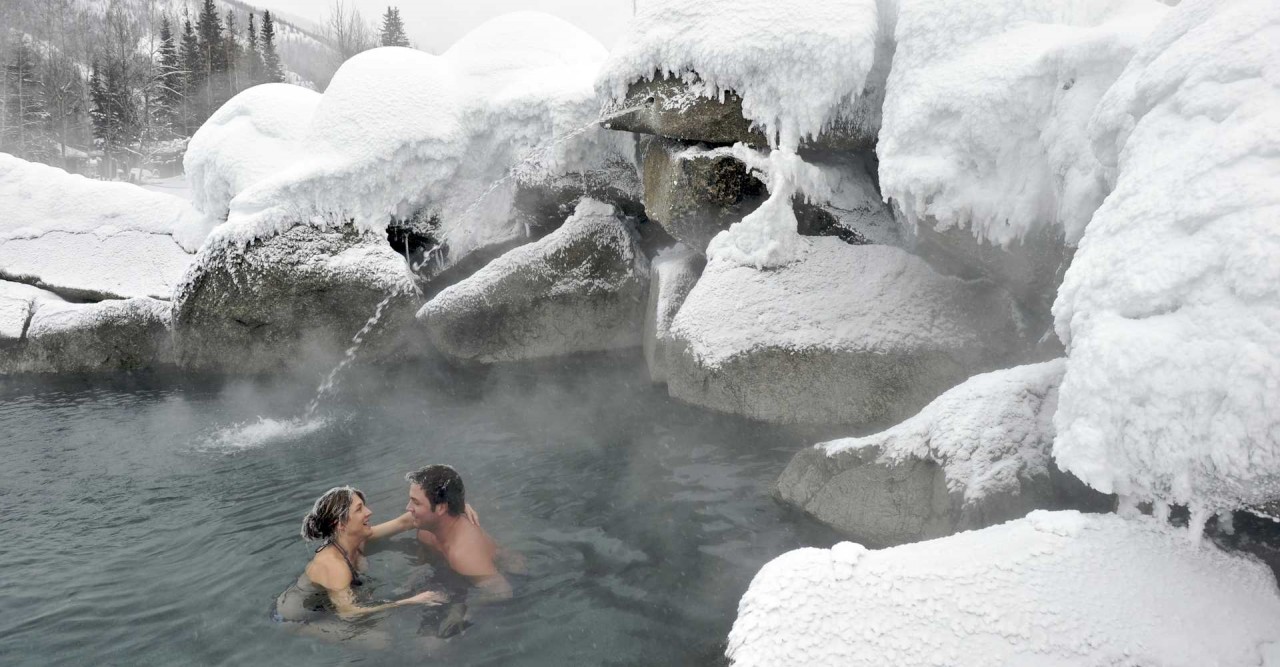 |
| Photo: Fairbanks, Alaska |
Chena Hot Springs Resort operates a big indoor pool and handsome outdoor wading lake, all of it constantly replenished by pungent mineral spring water that rises from the earth at about 165 degrees Fahrenheit. The facility has authentic Gold Rush roots and was already a premier destination for Alaska’s Interior by 1912, with people traveling by stage from Fairbanks. It remains a remarkable place to visit—probably the most accessible and popular hot springs in the state—with a reputation for open-air aurora viewing during winter. The resort includes a campground, cabins, and rooms to rent, a popular restaurant, tours of all kinds, and an indoor museum fashioned from 1,000 tons of ice. It’s also a snap to visit as a day trip from Fairbanks.
Indoors you’ll find a hot tub and a heated pool. The boulder-lined outdoor lake is handicapped accessible and restricted to adults. Its sandy bottom makes for comfortable walking, and patrons often stroll around until they find the Goldilocks sweet spot (not too hot, not too cold) for their soak, according to Alaska website.
5. Grand Prismatic Spring, Yellowstone National Park, Wyoming
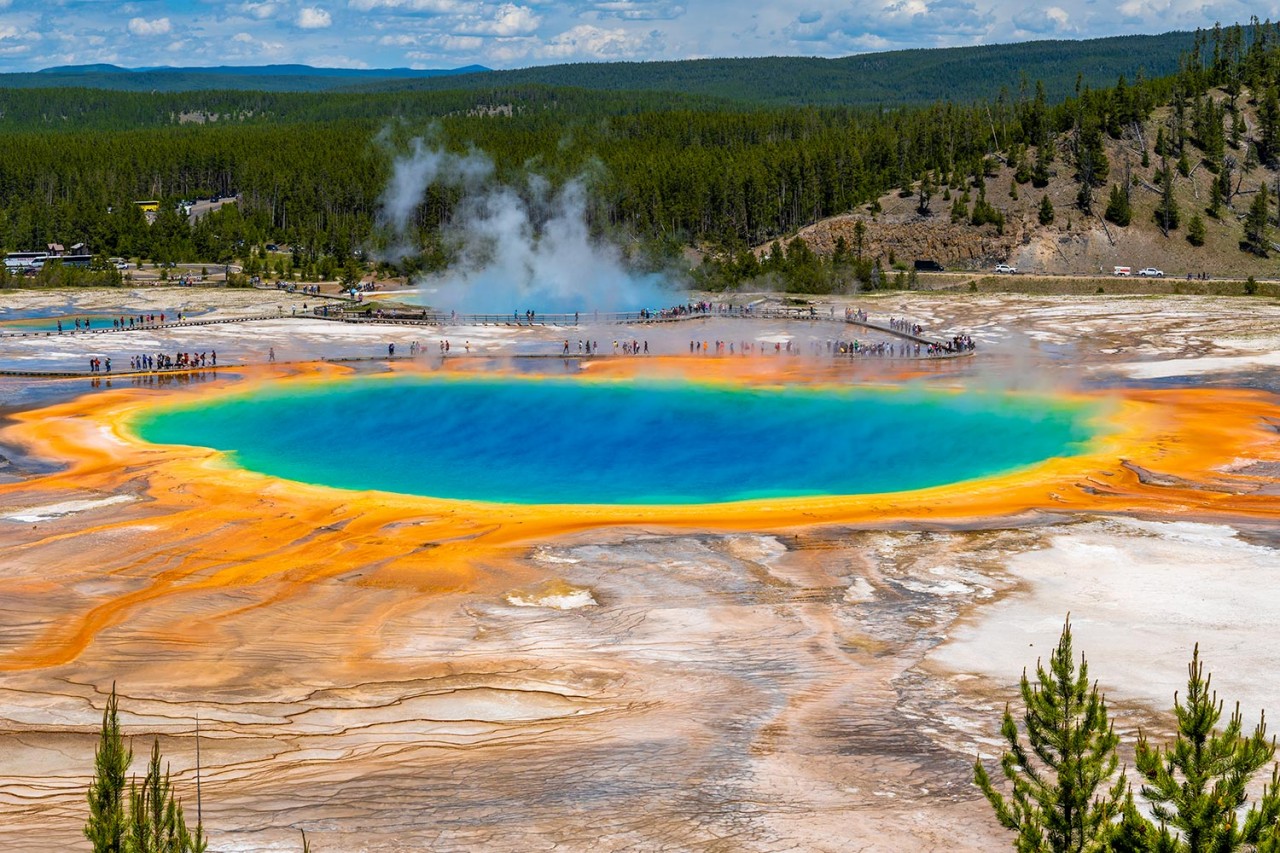 |
| Photo: Ace Adventurer |
First discovered in the early 1800s amidst the geysers and sulfurous bubblings of Yellowstone National Park, the record-setting natural wonder has been stunning visitors for over a century. The pool is a piercing blue surrounded by rings of color ranging from red to green. The otherworldly effect is caused by varieties of pigmented bacteria and microbes that thrive in the warm, mineral-abundant waters surrounding the hot spring. Changing along with the seasons the colors fade and grow more deep depending on what type of bacteria is thriving in the weather at the time. The center of the pool, where the water boils up from underground is so hot that the water is actually sterile. This produces a shockingly clear and bold blue color that the spring maintains year-round.
The Grand Prismatic Spring is one of America’s more beautiful sites to look at, just don’t touch as the boiling heat could likely melt the skin from bone, mixing blood-red into the deep blue, according to Atlas Obscura.
6. Kim Boi Hot Spring, Vietnam
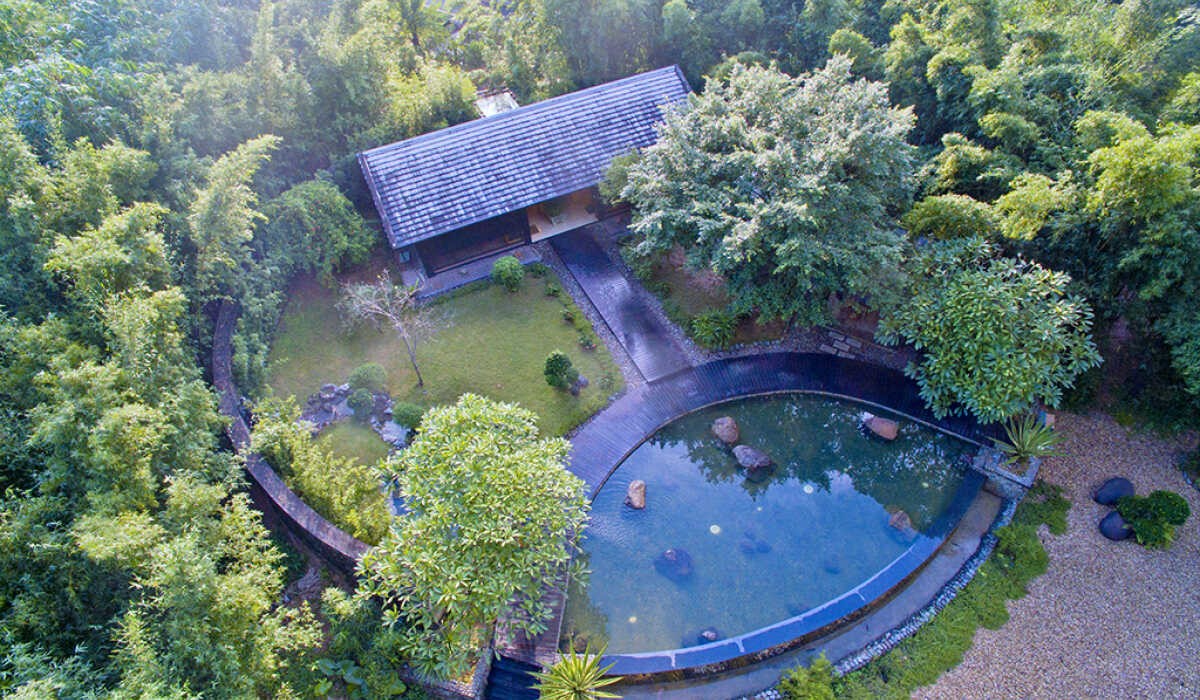 |
| Photo: Tripzone |
Kim Boi hot spring of Hoa Binh province is a natural mineral hot spring of Mo Da hamlet, Ha Bi commune, Kim Boi district, Hoa Binh province, about 70 km from Hanoi and about 30 km from Hoa Binh city.
Clearwater continually spouts from the fountains, normally between 340C and 360C. According to some scientific tests, Kim Boi water resources can reach the required standard for quality; therefore, it proves to be suitable for drinking and bathing. In fact, the Kim Boi mineral water is bottled for refreshment. It has almost the same composition as certain famous foreign brands of mineral water in the world. In addition, it is believed that heated water can hold more dissolved solids and have a high mineral content including calcium or lithium, or radium. As a result, this water is considered a highly effective therapy for rheumatism, intestinal diseases, stomachache, high blood pressure, etc. This can even be a good location for rehabilitation clinics for those with disabilities, according to Vietnam Online.
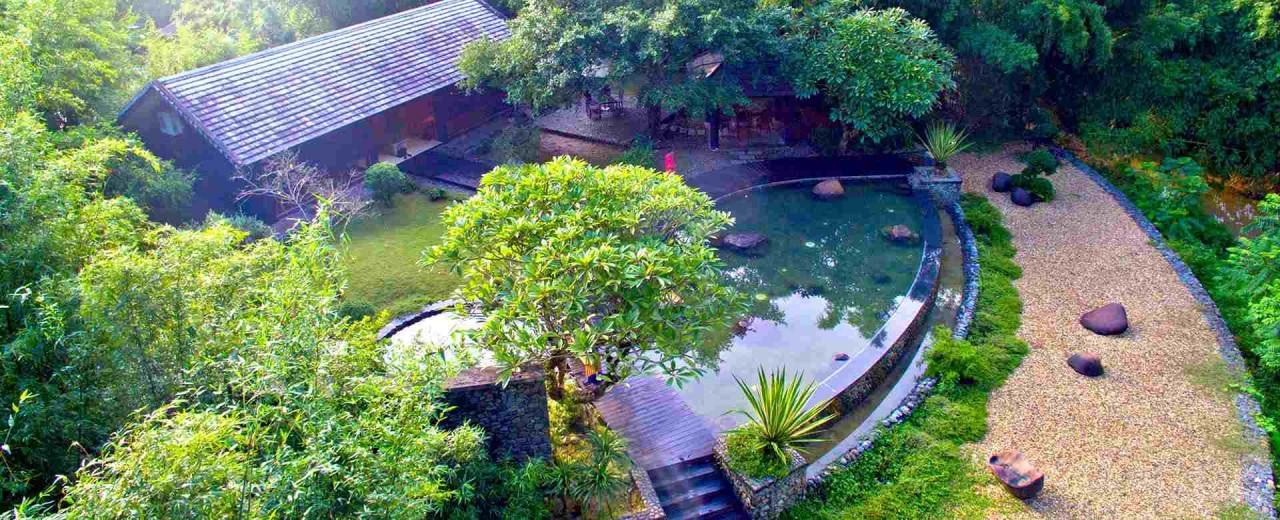 |
| Photo: BDS.Net |
After moments of relaxation in Kim Boi mineral spring, visitors can enjoy tasty dishes of the Northwest made from pork, buffalo, and chicken meat along with the vegetables getting from forests along with local rice with sesame. You can get totally different feel from the tastes that you tried in the plain or in the city.
7. Banjar Hot Springs, Bali, Indonesia
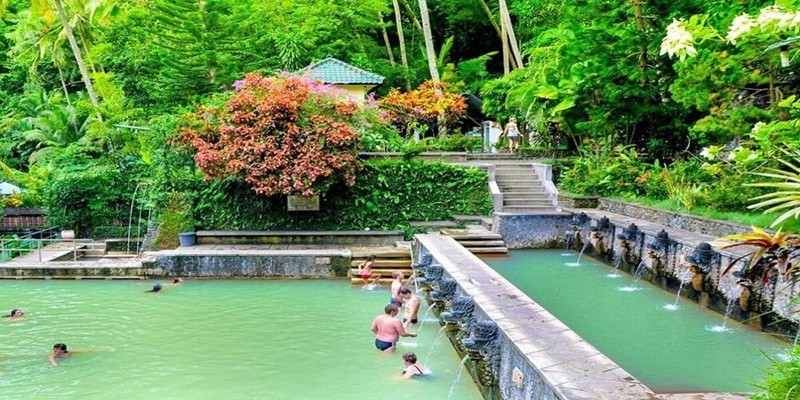 |
| Photo: Inclusive Bali Tour |
Banjar Hot Springs are centuries-old springs that have been upgraded with modern facilities over time. They have become a favorite retreat and recreational site among locals and international visitors.
Locally known as Air Panas Banjar, the hot springs are located approximately 5 km southwest of the famous Lovina coast in North Bali. They share the same district as the Brahmavihara Arama Buddhist monastery, which is located only 1.5 km to the east.
The hot water springs provide a recreational and therapeutic experience due to the water’s sulfur content. This can be seen from the yellowish-red sedimentation at several points of the spouts and pool walls.
The complex is known to have been further developed during the Japanese occupation of Indonesia during World War II. At the time, the waters of the hot springs were known to have cured various skin problems as well as rheumatic ailments.
Banjar Hot Springs continue to provide an enjoyable and health-benefiting retreat up in the hills of the north, for those seeking relaxation, fun, sightseeing, and a totally different experience. Those not willing to go for a swim can easily enjoy the lush tropical gardens, or the view from above at the Komala Tirta Restaurant, or shop for souvenirs at the rows of art shops just outside, according to Hotels.
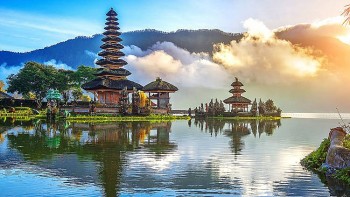 | Top 6 Most Beautiful Asia Countries That You Should Visit In Your Lifetime Cultural diversity, unique cuisine, wildlife, and scenic beauty are all the factors that make Asia the best destination for a winter holiday for first-time visitors ... |
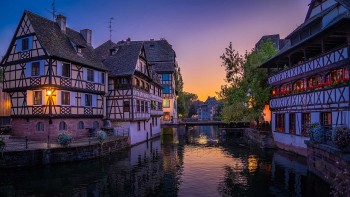 | A Journey To Strasbourg – A Beautiful Ancient City of Europe Strasbourg, which is called "The town at the crossroads", is a small lovely city with a length of history, friendly people, delicious traditional food, and ... |
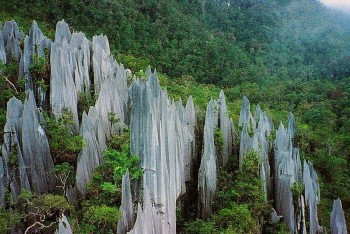 | Top 10 Most Stunning National Parks in Asia Asia is a most favorite destination in the world, with national parks being one of the tourist attractions that draw people from all over the ... |
Recommended
![[Photo] Peace Boat delegates immersed in Quang Ninh's Hues](https://vietnamtimes.org.vn/stores/news_dataimages/2025/052025/03/13/15ba8cdc6fa53a282f0ef99e14eb9cc5.jpg?rt=20250503130632) Multimedia
Multimedia
[Photo] Peace Boat delegates immersed in Quang Ninh's Hues
 Multimedia
Multimedia
Hanoi Hosts Friendship Exchange Celebrating 2025 Traditional New Year of Asian Countries
 Multimedia
Multimedia
Vietnamese People's Army Forcers in full dress parade rehearsal to celebrate the 50th anniversary of National Reunification
 Multimedia
Multimedia
In pictures: Fireworks Display in Hanoi Celebrates national reunification day
 Multimedia
Multimedia
Phong Nha-Ke Bang National Park Named Top Adventure Travel Site
 Multimedia
Multimedia
1,000 Women in Traditional Ao Dai Form Vietnam Map at Hoan Kiem Lake
 Multimedia
Multimedia
Vietnam’s Textile Industry Strengthens Position in Global Supply Chains
 Multimedia
Multimedia


